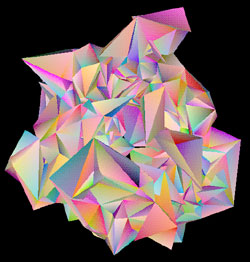Deriving Dimensions

For nearly 80 years physicists have struggled to reconcile the prevailing theory of gravity with quantum mechanics. According to Einstein’s general theory of relativity, mass and energy warp spacetime. The undulations then affect the trajectories of passing objects, producing the effects we call gravity. In Einstein’s theory, spacetime is a stretchy, dynamical entity.
However, the precise state of any dynamical thing remains uncertain, according to quantum mechanics. So at lengths of about 10-35 meters, spacetime can no longer be smooth, but must be roiling and frothy. That “quantum foam” bedevils researchers trying to concoct a quantum theory of gravity because in it concepts such as “ahead” and “behind” or “sooner” and “later” can lose their meaning. And no one has explained how the four-dimensional spacetime we take for granted emerges from the fantastical foam. Researchers have attempted to generate familiar four-dimensional spacetime by adding up all the possible configurations of the foam, thus borrowing a page from quantum mechanics, in which theorists assume that a particle travels between two points by taking every conceivable path at once. But these calculations have produced spacetimes that have either just two dimensions, or infinitely many.
The approach can produce a four-dimensional universe, however, if each particular version of the foam preserves a certain notion of cause and effect, report Renate Loll of the University of Utrecht in the Netherlands and colleagues. As in previous calculations, the researchers used a computer to generate approximate versions of all possible curved and frothy spacetimes by gluing together little triangular bits of flat four-dimensional spacetime, much as an artist might fashion abstract sculptures curving every which way by randomly gluing flat triangular tiles edge to edge. However, this time the researchers required that in each bit of spacetime nothing could travel faster than the speed of light, which implies that effects could never precede causes. In previous work, researchers imposed no such “causality.” The team also took care to connect the triangles together in a way that preserves the cause-before-effect ordering.
The researchers added up all the possible spacetimes to see if something like a large-scale four-dimensional spacetime would emerge from the sum. That was not guaranteed, even though the tiny bits of spacetime were four-dimensional. On larger scales the spacetime could curve in ways that would effectively change its dimension, just as a two-dimensional sheet of paper can be wadded into a three-dimensional ball or rolled into a nearly one-dimensional tube. This time the researchers found that they could achieve something that appeared to have one time dimension and three space dimensions–like the universe we know and love.
“It’s exceedingly important” work, says Lee Smolin of the Perimeter Institute for Theoretical Physics in Waterloo, Canada. “Now at least we know one way to do this.” Des Johnston of Heriot-Watt University in Edinburgh, Scotland, agrees the work is “very exciting” and says it underlines the importance of causality. “The other neat thing about this work is that you’re essentially reducing general relativity to a counting problem,” Johnston says. “It’s a very minimalist approach to looking at gravity.”
–Adrian Cho
Adrian Cho is a freelance science writer in Grosse Pointe Woods, Michigan.


